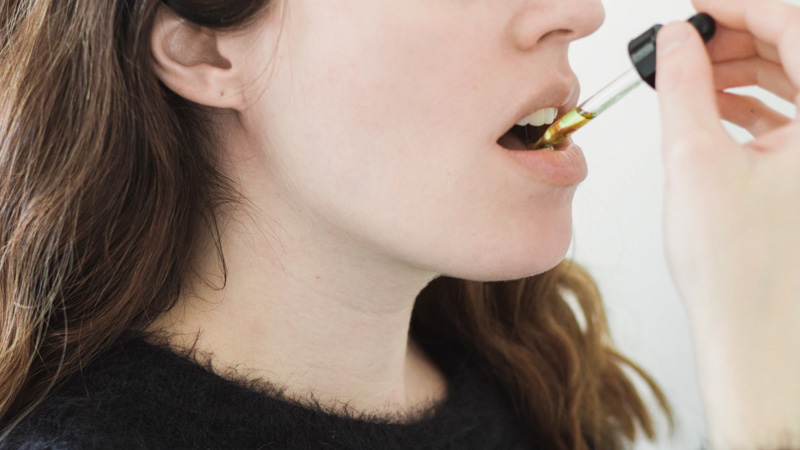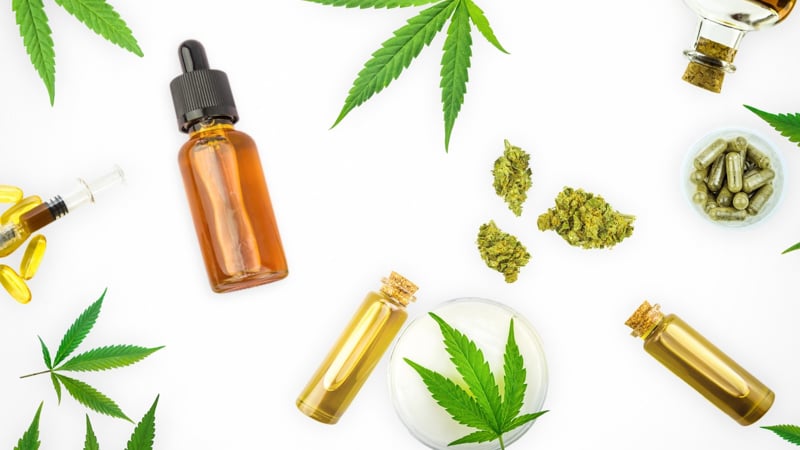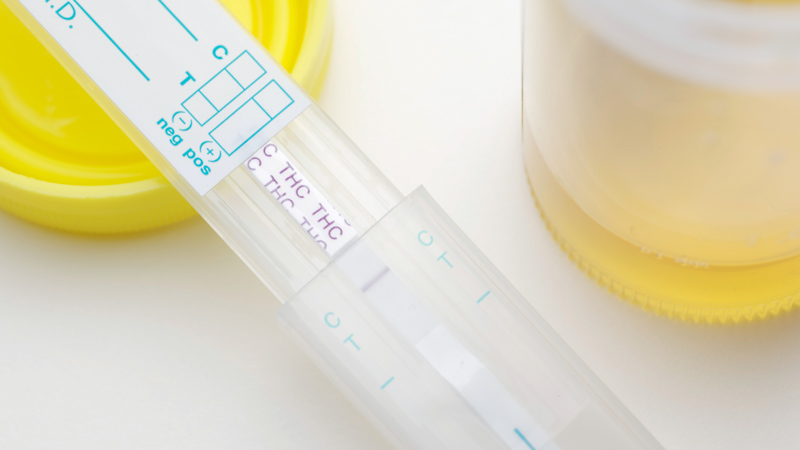One of the most common questions we get here at Gold Bee is, “How long does CBD oil stay in your system?”
As with everything you ingest, especially when it comes to active ingredients in supplements, it’s natural to ask questions about their effects, duration, and metabolism.
While CBD oil doesn’t get you high like marijuana products, it does get stored in your fat tissues. Common drug tests only look for THC metabolites, but some people are still concerned about how long CBD oil will last in their system.
Hemp was just legalized in 2018 under the amended Agricultural Act, and despite the rolling legalization movement (no pun intended here!), scientists are still trying to determine the time the metabolites of cannabis are stored in the user’s system.
This article will explain the time CBD acts in the body, how long it takes to flush CBD out of your system, and why it’s unlikely that it will cause you to fail a drug test.
How Long Does CBD Oil Stay in Your System? (Important Factors)

As much as we’d like to provide you with a universal timeframe for the time CBD oil will stay in your system, it’s easier said than done. Studies are limited in this regard, and different factors can influence the duration.
There are five major variables that determine how long CBD remains in your body:
The Dose of CBD
Usually, it takes about one day for CBD to be flushed out of your system after taking a single dose. However, the higher the dose, the more time your body will need to get rid of it.
How Often You Consume CBD
The frequency of use also determines how long CBD will stay in your system. CBD accumulates in the body over time if you’re a regular user. Most experts suggest taking CBD for at least two weeks to see how it affects your health and whether or not you’re reaping the benefits. For occasional users, the time CBD leaves the system is shorter.
Your Unique Body Chemistry
Everybody is different. People have different diets, lifestyle habits, metabolisms — all of which can affect the way they metabolize CBD. Your fat content, body mass index, and age will also influence the time CBD remains in the body.
Consumption Method
CBD is found in many different formats. The method of administration affects everything from the onset and duration of effects for the time required for the CBD to leave your system.
CBD is available as the following products:
- CBD oil
- CBD capsules
- CBD edibles (e.g. gummies and honey sticks)
- CBD vapes
- CBD topicals
The fastest and most efficient way to deliver CBD into your system is through vaporization. Vaping provides quick effects and leaves the body in a similar time manner. CBD oils and tinctures have a slower onset (15–20 minutes), but they last longer (up to 6 hours). Oral products like capsules and edibles need to pass through the digestive system, so their onset may be delayed by as much as 90 minutes. On the other hand, oral forms of CBD provide the longest duration, up to 10 hours. If you’re looking for localized relief from your discomfort, topicals are a good choice. Their absorption rate and duration time may vary depending on the product’s formula, so make sure to carefully read the ingredients list before buying.
Taking CBD on Empty / Full Stomach
How often you eat, how much, and what you eat plays an important role in the metabolism of CBD. If you take CBD on an empty stomach, it will be metabolized and eliminated faster than when you take it along with a meal.
Studies on CBD’s Metabolism: How Long Does It Stay In Your System?
As mentioned, there aren’t many studies investigating the time CBD oil stays in the user’s system. Below we present the most important research to date.
A 1991 study published in the journal Pharmacology, Biochemistry & Behavior examined the levels of CBD in the participants after high doses administered daily. The authors tested a daily dose of 700 mg of CBD on 14 patients with Huntington’s disease. One week after the experiment stopped, the CBD levels were measured at just 1.5 ng/mL. The research team concluded that CBD concentrations were “virtually undetectable.” (1)
According to a double-blind, randomized placebo-controlled 2005 study from the journal Therapeutic Drug Monitoring, low doses of CBD — 1.35 mg taken with 2.5 mg of THC —disappear from the body after nine hours from ingestion (2).
Finally, a 2018 review of existing CBD studies found that the estimated half-life of CBD from CBD oil was 2–5 days for daily users. Other methods of administration brought varying half-lives (3).
What is the Half-Life of a Substance?
The half-life of a compound is a popular unit in medicine that helps researchers determine the time it takes for half of the initial dose of a substance to leave one’s system (4).
Based on the assumption that the half-life of 10 mg CBD is 3 hours, the timeframe for how long CBD stays in your system works like this:
- 1 hour after administration – CBD reaches peak blood levels of 10 mg
- 3 hours (first half-life) – the amount of CBD is reduced to 5 mg
- 6 hours (second half-life) – there’s 2.5 mg of CBD in the body
- 9 hours (third half-life) – only 1.25 mg of CBD circulates in the body
- 12 hours (fourth half-life) – your body is left with 0.62 mg of CBD
As we said, the half-life of CBD depends on the consumption method and how often you take CBD oil.
How Long Do the Effects of CBD Oil Last?

The form of CBD determines how long your body will need for the effects to take hold — and how long they will last. It also affects the bioavailability of cannabidiol (5).
Here’s what to expect:
Sublingual CBD (CBD Oils, Tinctures & Sprays)
Sublingual use is a fairly efficient consumption method because CBD can pass directly into the bloodstream using the tiny capillaries under your tongue. This complex network of blood vessels allows the CBD to avoid the first-pass metabolism in the liver. Sublingual consumption produces its effects within 15–20 minutes after ingestion, lasting between 4–6 hours. The bioavailability of CBD oil — the amount that eventually enters the bloodstream — is measured at 35%.
Oral CBD (Capsules & Edibles)
Oral ingestion is one of the most common consumption methods for CBD products. Taking a capsule or eating a CBD gummy bear is a relatively effective way to reap the benefits of this cannabinoid. However, oral consumption is also the slowest way to deliver the effects of CBD. Since you swallow the product, the CBD needs to be metabolized in the gut before entering the bloodstream. From there, it can reach your endocannabinoid system within 30–90 minutes depending on your metabolism and whether or not you had eaten something before taking CBD.
This phenomenon is referred to as the “first-pass metabolism,” where the liver enzymes decrease the amount of CBD before its remaining dose can start circulating in the body. Although common among on-the-go users and those who dislike the taste of CBD oil, capsules come with the lowest bioavailability. Only up to 20% of swallowed CBD ends up in your bloodstream.
The delayed onset also leads to the gradual release of CBD into the endocannabinoid system, so the effects last longer than with oils — up to 10 hours.
Vaporized CBD
As mentioned earlier, vaporization provides the highest bioavailability of all CBD formats, with up to 56% of inhaled CBD entering your system. When you take a puff from your CBD vape pen or inhale the vapor from a high-CBD flower, the active ingredients enter the bloodstream using the lung tissue. Doing so ensures fast-acting effects; they usually take hold within 5 minutes after inhalation. On the other hand, they provide the shortest duration of all consumption methods; vaporized CBD will last up to 3 hours.
Topical CBD
Topical formulations range from creams to salves to gels, lotions, bath bombs, and other skin care products. This form of CBD is suited for people who want to target localized problems, such as irritation and discomfort. Sportspeople and athletes use CBD topicals to improve post-workout recovery. When you apply CBD to the skin, it reaches the epidermis layer, where the CB2 receptors are located. The activation of these receptors leads to an array of benefits related to skin health. Again, the absorption rates of CBD topicals vary between different formulas. Make sure to check the list of ingredients and look for the type of fats and oils used as the product’s base.
Will CBD Oil Show Up on a Drug Test?

In most cases, CBD won’t show up on a drug test.
The majority of drug tests are designed to look specifically for THC metabolites or other illicit substances. Employers must follow the Substance Abuse and Mental Health Services (SAMHSA) guidelines — and they don’t include detecting CBD.
But since hemp-derived CBD products may contain up to 0.3% of THC, this raises questions about the possibility of THC showing up on a drug test when the subject is a daily user.
The chances of testing false-positive for THC when taking full-spectrum CBD oil are extremely low. You would need to take around 2,000 milligrams daily to risk failing a drug test.
This can be easily avoided by choosing a broad-spectrum product that contains all the non-psychoactive ingredients of hemp, but without traces of THC. If you’re allergic to some of the hemp compounds, CBD isolate will be the safest bet.
How do you ensure that your CBD oil contains 0.3% of THC or less?
Always look for the Certificate of Analysis (CoA) from a third-party laboratory. An independent lab will look at the potency of CBD, the THC content in your CBD oil, and will detect any potential contaminants in the tested sample. Reputable companies share their lab reports with customers either on their websites or on request.
Even if you test false-positive for THC, you can tell your employer that you take full-spectrum CBD oil and ask for another screening.
How Long Is CBD Detectable in Urine?
Studies are limited when it comes to how long CBD stays in a person’s urine. A 2016 study conducted by researchers from Pacific Toxicology Laboratories in California found that CBD needed only 24 hours to flush CBD out of the subjects’ bodies. After two hours from the administration, 14 out of 15 participants still tested positive for CBD metabolites (6).
How Long Is CBD Detectable in the Blood?
Although not as common as urine tests, blood tests can be used to detect THC metabolites from CBD oil. The reason why they’re not the preferred method of drug testing is because of how quickly THC is eliminated from the bloodstream. The time THC and CBD are detectable in your plasma is about five hours after you take it. However, their metabolites can be present for up to a week.
How Long Is CBD Detectable in the Hair?
A hair test can detect drugs for an extended period of time. These tests can detect the THC metabolites from CBD oil for as long as three months post-administration. The time CBD stays in your hair isn’t clear, but hair tests are very uncommon for both cannabinoids.
Does CBD Interact with Medications?
CBD-induced drug interactions are a real thing. CBD may either shorten or prolong the time it takes to flush the active ingredients in medications from the body.
CBD acts as a substrate and inhibitor of CYP450 enzymes, which metabolize the substances in drugs. Therefore, CBD may affect the metabolism of many pharmaceuticals. Depending on the type of interaction, CBD may cause a subtherapeutic effect, or lead to excessive concentrations of the drug in the bloodstream.
If you take any medications, we encourage you to consult a doctor you trust to avoid the said interactions and maximize the health benefits of CBD oil.
Is CBD Toxic for the Liver?
One study on mice has found that extremely high doses of CBD administered acutely can increase the number of liver enzymes and cause toxicity. However, the results haven’t been replicated in humans, not to mention that the CBD dose was exorbitant considering the weight of the mice. Some studies report that CBD is well tolerated in daily doses of up to 1,500 mg. The World Health Organization (WHO) has also acknowledged CBD as a safe substance.
That being said, CBD has a few mild side effects when taken in large doses. These include dry mouth, changes in appetite, dizziness, fatigue, and diarrhea.
The good news is that none of these reactions are life-threatening, not to mention that it’s impossible to fatally overdose on cannabinoids.
CBD and Breastfeeding: Can CBD Pass Into Your Baby’s System?
Doctors suggest that breastfeeding mothers abstain from CBD for at least 1 week before they start breastfeeding. The Food and Drug Administration (FDA) holds a strong stance against the use of CBD during breastfeeding due to the lack of sufficient research on how CBD affects breastfed babies. We only know that some amount of cannabinoid can pass into a baby’s bloodstream with milk.
Until researchers establish the safety of CBD during breastfeeding, it’s safe to avoid it.
So, How Long Does CBD Oil Stay in Your System?
Low-to-moderate doses administered acutely shouldn’t stay in your system for more than 24 hours. Even high doses of CBD should disappear from the body within a week.
However, regular use of CBD may cause it to remain longer in your system. For some people, it takes more than a week to flush CBD completely out of the body. That’s because CBD builds up over time in the fat tissues.
The time CBD oil will stay in your system is determined by several factors, including your age, metabolism, weight, dosage, frequency of use, consumption method, and the use of other medications.
The good news is that drug tests don’t look for CBD, so if you take normal doses of full-spectrum CBD oil, you’re in the clear.
We hope you’ll find this article useful for further research. If you know about any new discoveries in terms of how long CBD stays in one’s system, feel free to leave a comment below! All of our articles are regularly updated according to the latest research.
References:
- Consroe, P et al. “Assay of plasma cannabidiol by capillary gas chromatography/ion trap mass spectroscopy following high-dose repeated daily oral administration in humans.” Pharmacology, biochemistry, and behavior vol. 40,3 (1991): 517-22. doi:10.1016/0091-3057(91)90357-8
- Nadulski, Thomas et al. “Randomized, double-blind, placebo-controlled study about the effects of cannabidiol (CBD) on the pharmacokinetics of Delta9-tetrahydrocannabinol (THC) after oral application of THC versus standardized cannabis extract.” Therapeutic drug monitoring vol. 27,6 (2005): 799-810. doi:10.1097/01.ftd.0000177223.19294.5c
- Millar, Sophie A et al. “A Systematic Review on the Pharmacokinetics of Cannabidiol in Humans.” Frontiers in pharmacology vol. 9 1365. 26 Nov. 2018, doi:10.3389/fphar.2018.01365
- Millar, Sophie A et al. op. cit.
- Millar, Sophie A et al. op. Cit.
- Wertlake, Paul T, and Michael D Henson. “A urinary test procedure for identification of cannabidiol in patients undergoing medical therapy with marijuana.” Journal of pain research vol. 9 81-5. 12 Feb. 2016, doi:10.2147/JPR.S96856
